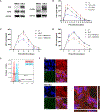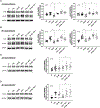Extracellular vesicles regulate gap junction-mediated intercellular communication and HIV-1 infection of human neural progenitor cells
- PMID: 33962010
- PMCID: PMC9056881
- DOI: 10.1016/j.nbd.2021.105388
Extracellular vesicles regulate gap junction-mediated intercellular communication and HIV-1 infection of human neural progenitor cells
Abstract
Human immunodeficiency virus-1 (HIV-1) has been shown to cross the blood-brain barrier and cause HIV-associated neurocognitive disorders (HAND) through a process that may involve direct or indirect interactions with the central nervous system (CNS) cells and alterations of amyloid β (Aβ) homeostasis. The present study focused on the mechanisms of HIV-1 infecting human neural progenitor cells (hNPCs) and affecting NPC intercellular communications with human brain endothelial cells (HBMEC). Despite the lack of the CD4 receptor, hNPCs were effectively infected by HIV-1 via a mechanism involving the chemokine receptors, CXCR4 and CCR5. HIV-1 infection increased expression of connexin-43 (Cx43), phosphorylated Cx43 (pCx43), and pannexin 2 (Panx2) protein levels in hNPCs, suggesting alterations in gap-junction (GJ) and pannexin channel communication. Indeed, a functional GJ assay indicated an increase in communication between HIV-infected hNPCs and non-infected HBMEC. We next analyzed the impact of HBMEC-derived extracellular vesicles (EVs) and EVs carrying Aβ (EV-Aβ) on the expression of Cx43, pCx43, and Panx2 in HIV-1 infected and non-infected hNPCs. Exposure to EV-Aβ resulted in significant reduction of Cx43 and pCx43 protein expression in non-infected hNPCs when compared to EV controls. Interestingly, EV-Aβ treatment significantly increased levels of Cx43, pCx43, and Panx2 in HIV-1-infected hNPCs when compared to non-infected controls. These results were confirmed in a GJ functional assay and an ATP release assay, which is an indicator of connexin hemichannel and/or pannexin channel functions. Overall, the current study demonstrates the importance of hNPCs in HIV-1 infection and indicates that intercellular communications between infected hNPCs and HBMEC can be effectively modulated by EVs carrying Aβ as their cargo.
Keywords: Amyloid β; Connexins; Extracellular vesicles; HIV-1; Human neural progenitor cells; Pannexins.
Copyright © 2021 The Authors. Published by Elsevier Inc. All rights reserved.
Conflict of interest statement
Declaration of Competing Interest
The authors declare no conflict of interest.
Figures





Similar articles
-
Extracellular Vesicle-Serpine-1 Affects Neural Progenitor Cell Mitochondrial Networks and Synaptic Density: Modulation by Amyloid Beta and HIV-1.Mol Neurobiol. 2023 Nov;60(11):6441-6465. doi: 10.1007/s12035-023-03456-y. Epub 2023 Jul 17. Mol Neurobiol. 2023. PMID: 37458985 Free PMC article.
-
HIV-1 and Amyloid Beta Remodel Proteome of Brain Endothelial Extracellular Vesicles.Int J Mol Sci. 2020 Apr 15;21(8):2741. doi: 10.3390/ijms21082741. Int J Mol Sci. 2020. PMID: 32326569 Free PMC article.
-
Extracellular vesicle-mediated amyloid transfer to neural progenitor cells: implications for RAGE and HIV infection.Mol Brain. 2020 Feb 17;13(1):21. doi: 10.1186/s13041-020-0562-0. Mol Brain. 2020. PMID: 32066471 Free PMC article.
-
Role of connexin 43 in different forms of intercellular communication - gap junctions, extracellular vesicles and tunnelling nanotubes.J Cell Sci. 2017 Nov 1;130(21):3619-3630. doi: 10.1242/jcs.200667. Epub 2017 Oct 12. J Cell Sci. 2017. PMID: 29025971 Review.
-
[Intra- and intercellular Ca(2+)-signal transduction].Verh K Acad Geneeskd Belg. 2000;62(6):501-63. Verh K Acad Geneeskd Belg. 2000. PMID: 11196579 Review. Dutch.
Cited by
-
The role of extracellular ATP and P2X receptors in the pathogenesis of HIV-1.Curr Opin Pharmacol. 2023 Apr;69:102358. doi: 10.1016/j.coph.2023.102358. Epub 2023 Feb 27. Curr Opin Pharmacol. 2023. PMID: 36848824 Free PMC article. Review.
-
Viral Infection and Connexin Dysfunction in the Heart.Curr Cardiol Rep. 2025 Mar 27;27(1):76. doi: 10.1007/s11886-025-02227-6. Curr Cardiol Rep. 2025. PMID: 40146392 Free PMC article. Review.
-
Occludin Regulates HIV-1 Infection by Modulation of the Interferon Stimulated OAS Gene Family.Mol Neurobiol. 2023 Sep;60(9):4966-4982. doi: 10.1007/s12035-023-03381-0. Epub 2023 May 20. Mol Neurobiol. 2023. PMID: 37209263 Free PMC article.
-
Occludin regulates HIV-1 infection by modulation of the interferon stimulated OAS gene family.Res Sq [Preprint]. 2023 Jan 30:rs.3.rs-2501091. doi: 10.21203/rs.3.rs-2501091/v1. Res Sq. 2023. Update in: Mol Neurobiol. 2023 Sep;60(9):4966-4982. doi: 10.1007/s12035-023-03381-0. PMID: 36778388 Free PMC article. Updated. Preprint.
-
Pericyte infection by HIV-1: a fatal attraction.Retrovirology. 2022 Dec 7;19(1):27. doi: 10.1186/s12977-022-00614-3. Retrovirology. 2022. PMID: 36476484 Free PMC article. Review.
References
-
- Alvarez Losada S, Cantó-Nogués C, Muñoz-Fernández MA, 2002. A new possible mechanism of human immunodeficiency virus type 1 infection of neural cells. Neurobiol Dis. 11, 469–478. - PubMed
Publication types
MeSH terms
Substances
Grants and funding
LinkOut - more resources
Full Text Sources
Other Literature Sources
Medical
Research Materials
Miscellaneous

